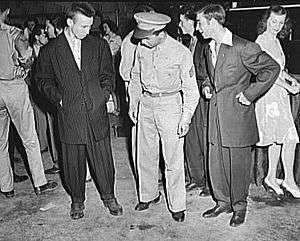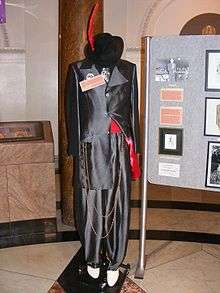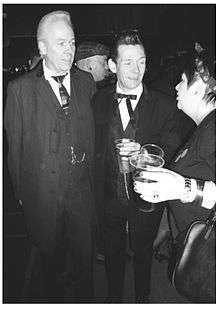Zoot suit

A zoot suit (occasionally spelled zuit suit[1]) is a men's suit with high-waisted, wide-legged, tight-cuffed, pegged trousers, and a long coat with wide lapels and wide padded shoulders. This style of clothing became especially popular among the Latino, African American, Italian American, and Filipino American communities during the 1940s.[2][3]
Some observers claim that the "Edwardian-look" suits with velvet lapels worn by Teddy Boys in Britain are said to be a derivative of the zoot suit.[4]
History

Zoot suits were first associated with African Americans in urban communities such as Harlem, Chicago, and Detroit, but were made popular by jazz musicians in the 1940s. According to the Oxford English Dictionary, the word "zoot" probably comes from a reduplication of suit. The creation and naming of the zoot suit have been variously attributed to Harold C. Fox, a Chicago clothier and big-band trumpeter;[5] Charles Klein and Vito Bagnato of New York City;[6] Louis Lettes, a Memphis tailor;[7] and Nathan (Toddy) Elkus, a Detroit retailer.[8][9]
"A Zoot Suit (For My Sunday Gal)" was a 1942 song written by L. Wolfe Gilbert and Bob O'Brien.[10]
Cab Calloway frequently wore zoot suits on stage and in the 1943 film Stormy Weather, including some with exaggerated details, such as extremely wide shoulders or overly draped jackets.
In 1943 during World War II there were a series of anti-Mexican youth riots in Los Angeles known as the Zoot Suit Riots. Norris J. Nelson, Los Angeles City Council member, proposed outlawing zoot suits after the Riots.The suits worn by many of the youth were seen by some as unpatriotic because of the amount of fabric they used, and in time, zoot suits were prohibited for the duration of the war,[11] ostensibly because of their wastefulness of cloth.[12]
Pachuco was a style of Mexican-American dress and culture, is which was associated with the zoot suit.
Tin-Tan, a famous Mexican actor from the 1940s, wore zoot suits in his films.
The 38th street gang, was a Los Angeles street gang known for wearing the zoot suit in the 1940s.
Characteristics


Traditionally, zoot suits have been worn with a fedora or pork pie hat color-coordinated with the suit, occasionally with a long feather as decoration, and pointy, French-style shoes.
A young Malcolm X, who wore zoot suits in his youth, described the zoot suit as: "a killer-diller coat with a drape shape, reet pleats, and shoulders padded like a lunatic's cell".[13] Zoot suits usually featured a watch chain dangling from the belt to the knee or below, then back to a side pocket. A woman accompanying a man wearing a zoot suit commonly would herself wear a flared skirt and a long coat.[14]
The amount of material and tailoring required made them luxury items, so much so that the U.S. War Production Board said that they wasted materials that should be devoted to the World War II war effort.[15] When Life published photographs of zoot suiters in 1942, the magazine joked that they were "solid arguments for lowering the Army draft age to include 18-year-olds".[14] This extravagance, which many considered unpatriotic in wartime, was a factor in the Zoot Suit Riots. To some, wearing the oversized suit was a declaration of freedom and self-determination, even rebelliousness.[16][17]
See also
- Zazou
- Zoot Suit (film)
- The Zoot Cat
References
- ↑ Calderin, Jay (2013). The Fashion Design Reference & Specification Book: Everything Fashion Designers Need to Know Every Day. Rockport Publishers. ISBN 978-1-59253-850-8.
- ↑ Walker, John. (1992) "Zoot suits". Glossary of Art, Architecture & Design since 1945, 3rd. ed. Retrieved 19 January 2012.
- ↑ Maddan, Heather (April 29, 2007). "Zooting up / Brighten prom night with flash, dash - and panache". The San Francisco Chronicle.
- ↑ Mazón, Mauricio (2010). The Zoot-Suit Riots: The Psychology of Symbolic Annihilation. University of Texas Press. ISBN 9780292788213. Retrieved 30 January 2016.
- ↑ McG. Thomas, Robert (August 1, 1996). "Harold Fox, Who Took Credit For the Zoot Suit, Dies at 86". The New York Times. Retrieved September 11, 2012.
- ↑ Clipping from The Daily Telegram (Adrian, Michigan), June 28, 1943, p. 8.
- ↑ Bird, Christiane (2001). The Da Capo Jazz And Blues Lover's Guide To The U.S. Da Capo Press. ISBN 978-0-306-81034-3.
- ↑ "Nathan Elkus, 89, Detroit retailer". Daily News Record. January 2, 1992. Retrieved September 11, 2012.
- ↑ Elkus, Philip L. (August 4, 1996). "Zoot Suit Required Cutting and Cajoling". The New York Times. Retrieved September 11, 2012.
- ↑ Azizi Powell, "Two Examples of the 1942 Song 'Zoot Suit (For My Sunday Gal)'". Pancojams, February 12, 2014.
- ↑ "People & Events: The Zoot Suit Riots of 1943", The American Experience; retrieved June 5, 2013.
- ↑ Use of cloth had already been limited; zoot suits were also seen as unpatriotic. War, Politics & Suits: The Zoot Suit, Duchess Clothier; retrieved June 5, 2013.
- ↑ Lennard, John (2007). Walter Mosley: "Devil in a Blue Dress" (e-book). Humanities-Ebooks. p. 45. ISBN 978-1-84760-042-4. Retrieved 2009-04-22.
- 1 2 "Zoot suits". Life. 1942-09-21. p. 44. Retrieved November 20, 2011.
- ↑ Rottman, Gordon L. (2007). FUBAR: Soldier Slang of World War II. Oxford: Botley. p. 117. ISBN 978-1-84603-176-2.
- ↑ Osgerby, Bill (2008). "Understanding the 'Jackpot Market': Media, Marketing, and the Rise of the American Teenager". In Patrick L. Jamieson & Daniel Romer. The Changing Portrayal of Adolescents in the Media Since 1950. New York: Oxford University Press US. pp. 31–32. ISBN 0-19-534295-X.
- ↑ Kelley, Robin, Seven Songs for Malcolm X, 1993, film by John Akomfrah.
Further reading
- Alvarez, Luis. The Power of the Zoot: Youth Culture and Resistance During World War II (University of California Press, 2008).
- Cosgrove, Stuart (1984). "The Zoot-Suit and Style Warfare". History Workshop Journal. 18: 77–91. doi:10.1093/hwj/18.1.77. Archived from the original on 2014-08-13. Republished in: Cosgrove, Stuart (2005). "The Zoot-Suit and Style Warfare". In Cameron, Ardis. Looking for America: The Visual Production of Nation and People. pp. 264–80. doi:10.1002/9780470774885.ch10. ISBN 978-1-4051-1465-3.
- Turner, Ralph H.; Surace, Samuel J. (1956). "Zoot-Suiters and Mexicans: Symbols in Crowd Behavior". American Journal of Sociology. 62 (1): 14–20. doi:10.1086/221893. JSTOR 2773799.
- Tyler, Bruce (1994). "Zoot-Suit Culture and the Black Press". The Journal of American Culture. 17 (2): 21–33. doi:10.1111/j.1542-734X.1994.00021.x.
- Alford, Holly (2004). "The Zoot Suit: Its History and Influence". Fashion Theory. 8 (2): 225–36. doi:10.2752/136270404778051807.
- del Castillo, Richard Griswold (2000). "The Los Angeles 'Zoot Suit Riots' Revisited: Mexican and Latin American Perspectives". Mexican Studies. 16 (2): 367–91. doi:10.1525/msem.2000.16.2.03a00080. JSTOR 1052202.
External links
- The Zoot Suit Riots. Article about the zoot suit riots of 1943.
- "Powerdressing - Zoot suits". History, Periods & Styles. Victoria and Albert Museum. Retrieved 2008-06-11.